The Hasivo S1100P-8GT may not be a common option, but it offers something completely unique. Namely, it is an ultra-low-cost 2.5GbE switch that also offers PoE+ with a relatively generous power budget. In this review, we are going to look at the switch and then talk about the high and low points of our experiences thus far. For some perspective, this switch costs about the same as a 1GbE Netgear PoE switch, yet it also has a higher power budget. This is also about the same price as the TP-Link TL-SH1008 we reviewed. With that, let us get to the hardware.
Video Version
Just to also show this to our YouTube audience, we also have a video version of this piece you can find here:
On the video we also get to pan through the test setup a bit more than we do in photos so if you want to see more gear like an IP camera and the Netgear WAX630 WiFi 6 AP, then you can see them a bit more in the video. As always, we suggest opening the video in a new tab, browser, or app for a better viewing experience.
Hasivo S1100P-8GT 2.5GbE PoE+ Switch External Hardware Overview
The Hasivo S1100P-8GT is one where there is precious little information available. We could not find any information outside of AliExpress, Taobao, and Chinese language websites. Still, for $121 (+$28 shipping) we received a desktop switch after a bit of a wait.
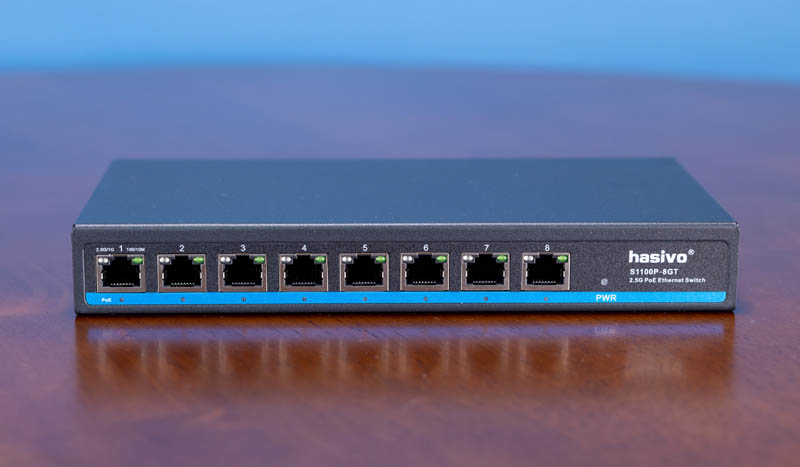
The switch’s main feature is perhaps the 2.5GbE ports. This is an 8-port unmanaged switch and it can do 2.5GbE and 1GbE. We tested both. The 10M/100M it is rated to achieve, but we did not get to test across every port.
We will note that there is a large blue line across the bottom of the ports. Hasivo has a non-PoE version of this switch for just under $100 + 28 shipping. With shipping it is a bit more expensive than the TP-Link that we just reviewed. The reason we got this model instead is that adding PoE capabilities was less than a $30 upgrade. Hasivo charges much less for PoE than many other SMB networking vendors.

That blue strip also has a LED indicator for PoE being active. You can see under Port 2’s red Ethernet cable the amber LED showing that the switch is powering a device over PoE.

The sides of the switch are just vents to allow a little airflow.

The rear of the switch has a DC power input and a grounding point.

The PSU that came with the unit is a 52V 2.5A unit. For a $121 switch, this is a very healthy size power supply.
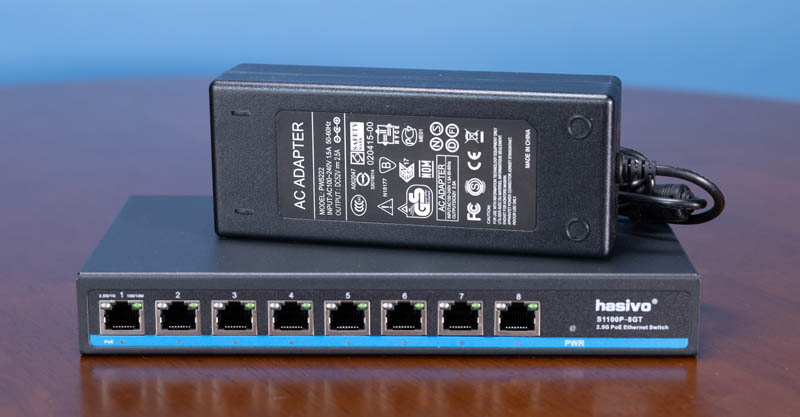
While the PSU has certification and compliance marks, the switch does not. There are no certification marks on the switch itself and the label is relatively simple. This is not a 2.5Gbps switch, instead it is a “2.5GDPS” switch that can supply PoE+ power to a number of ports and up to 90W to one.
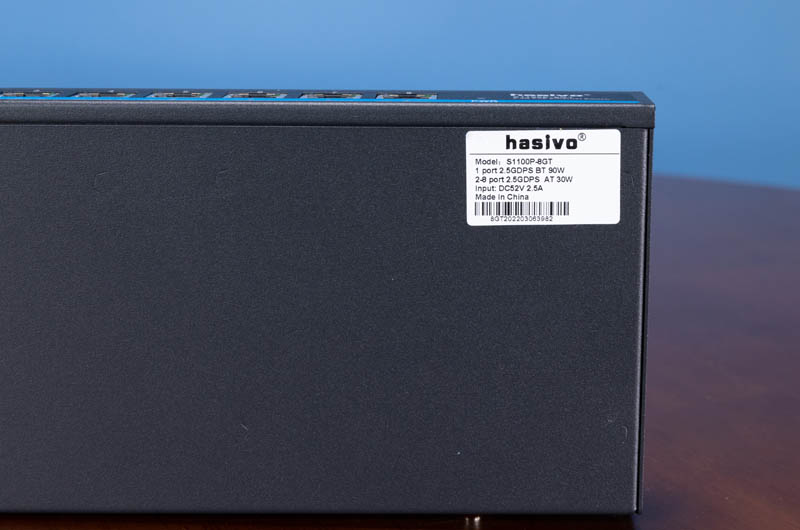
There are a few hints that this is not a perfect setup. For one, the switch lacks mounting holes to screw into a desk, wall, or elsewhere. There are no rack ears. Also, we did not get rubber feet with this, so it was essentially a metal box.
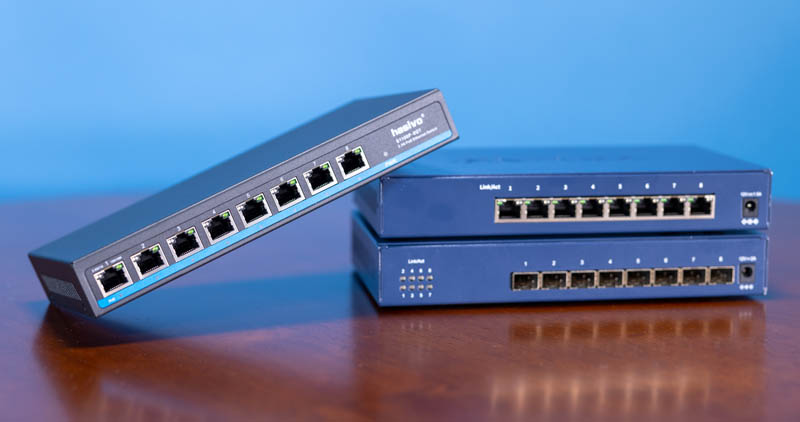
Compared to the TP-Link switches, this is actually a bit smaller which is also nice.
Next, let us get inside the switch and see what is going on there.

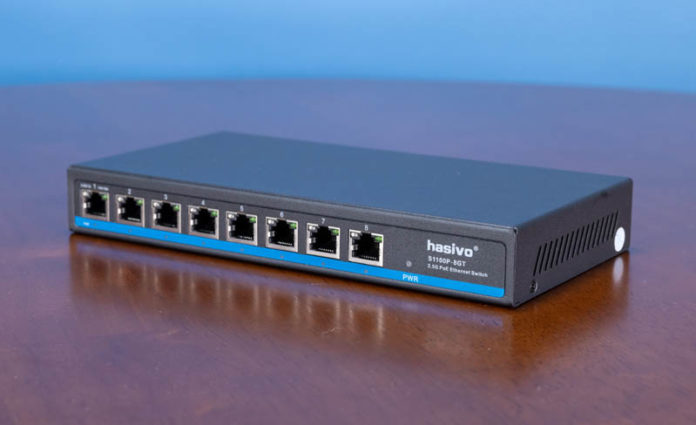



I’m waiting for a 5GbE POE++ 5 or 8 port switch. Any of those on the horizon?
@Pete – It seems like the industry is skipping over 5 GbE. It is rare anything supports 5 GbE unless it’s a hybrid 1/2.5/5/10 GbE device.
I think the big issue is anything not very new only has bandwidth to support 2.5G max, and anything new either comes with 2.5G (cheaper) or 10G (more premium), at least in the consumer space.
For 125 USD (845 RMB) I get a Hasivo switch with 24 ports POE + 1 SPF port in China. 400 watts POE power.
It’s always amazing to see how Aliexpress is adding a fat margin. The switch featured in the video is around 40 USD in China.
I’d call this less or least expensive, but certainly not cheap or cheapest.
Big improvement over 1GbE, but looks at least 10% under actual 2.5GbE? There’s always overhead, though negligible at 1GbE? The performance section is couched; “speeds well in excess of 1GbE” and “performance we would expect [for this switch chip]”. Are there known better-performing switch chips?
When you do these reviews, could you include whether the PoE is isolated or not? If the switch does not isolate the PoE then it’s possible to short circuit the switch’s power supply, as happened with a lot of older TP-Link 1Gbps switches.
This is because some switches connect the power supply positive rail to PoE GND, and the power supply negative rail to PoE power, to give -48VDC from a power supply that delivers +48VDC. All power supplies internally connect their negative rail to the earth connection. This means any PoE device (that is not itself isolated, which most of them aren’t) will end up with its ground connection electrically connected to the PoE supply’s positive DC output, but every other appliance will have its ground connection electrically connected to the PoE supply’s negative DC output. So if you connect the two grounds together you end up short circuiting the switch power supply and the whole switch loses power.
You can easily test this by powering a Raspberry Pi via PoE, and connecting it via HDMI to an external monitor. The HDMI shield on the Pi will be connected to the PoE positive supply, but the HDMI shield on the monitor will be connected to the PoE negative supply, so as soon as you connect the HDMI cable the PoE supply gets short circuited – if the switch does not isolate the supply. (Note both the PoE switch and the monitor must be plugged into earthed wall outlets for this to happen.)
You can also test this in a less catastrophic way by using a multimeter to measure the voltage between the grounded metal parts (e.g. the Pi HDMI socket) and metal parts on other appliances, like a server rack. There should be close to zero volts between them, but if you see around 48 volts, then there is no isolation.
You can work around this by using an isolated PoE splitter, but not all PoE splitters are isolated.
It’s a problem because if you want to power any sort of digital signage, you can’t do it unless either the switch or your PoE splitters are isolated. All Cisco PoE switches appear to be isolated so it’s never a problem with higher end equipment, but the lower end stuff is a bit of an unknown until you test it.
Is it really cheep when you have to wait for it to be shipped by sea to your country, then wait for it to be handled at an overloaded port, and then finally brought to you?
What is your time worth in dollars? Once you understand that “cost” you will understand the true “economic cost” of the cheep stuff that is pushed on STH.
I prefer stuff that I can buy locally, off the shelf, or from a supplier located within my own country. I know that last option isn’t available to everyone.
@Sleepy if you can plan ahead then shipping time is not an issue.
And when the price from local supllier is 2x of aliexpress then you have a choice to be made
It might be interesting for STH to engage an up-to-date electrical safety / liability expert (not me), to opine on issues with procuring devices lacking complete and credible safety declarations.
In the present case, just considering the external PSU (a 52 Vdc 2.5A output device), there are about 21 different safety marks that might appear. The photo is not entirely legible. The plug tip is also not visible, so I can’t guess as to whether it might be sufficiently shrouded to be considered “guarded”.
On the marks, I don’t see CSA or UL/UR, for which one applicable UL might be 508A 43.1.2 (42.4 Vdc).
I do see EN/EC and CE Mark, but if the plug is unguarded, I’m wondering how this really meets, for example, EN62368 and/or EN61010 (might meet a Vdc limit, but fail current limit).
Now, for US market, one might not care about the Euro standards, but for any operation subject to OSHA, unguarded 52 Vdc won’t meet the 50V limit of 29 CFR 1910.303(g)(2)(i), nor NFPA 70E, Article 130 (50V).
Sfp28 optics are affordable. When will we see reasonably priced sfp28 switches?
But can it be POWERED by POE+?!
No! Of course not! Because no one on this Earth has steeped up to meet that demand!
Have you tried running it for several days or a week continuously and checking for stability? The QNAP one built on this chip freezes randomly requiring a manual power cycle (check the review on Amazon, and I’ve experienced this too)
Please, return to normal (previous) way of showing the hardware.
Now you hanging it in hands with almost no close ups. There is no way to look at details.
Previous presentation way was better. Please return to normal…
Can you do a explanation of the switch types, viz, unmanaged switch vs level 2 switch vs level 3 switch with use cases. If it has been done, please link the article
Will this switch forward / pass through vlan tags?